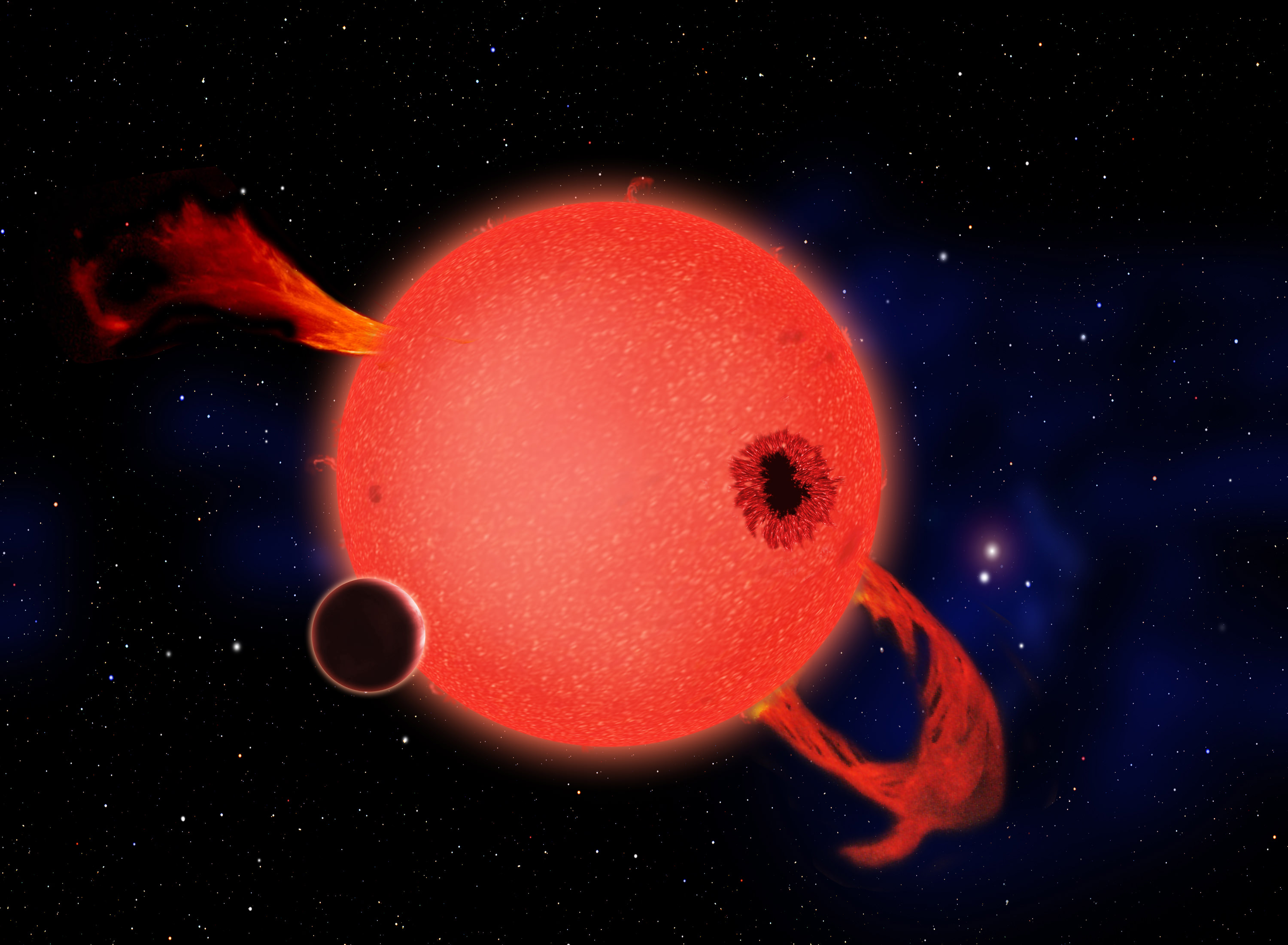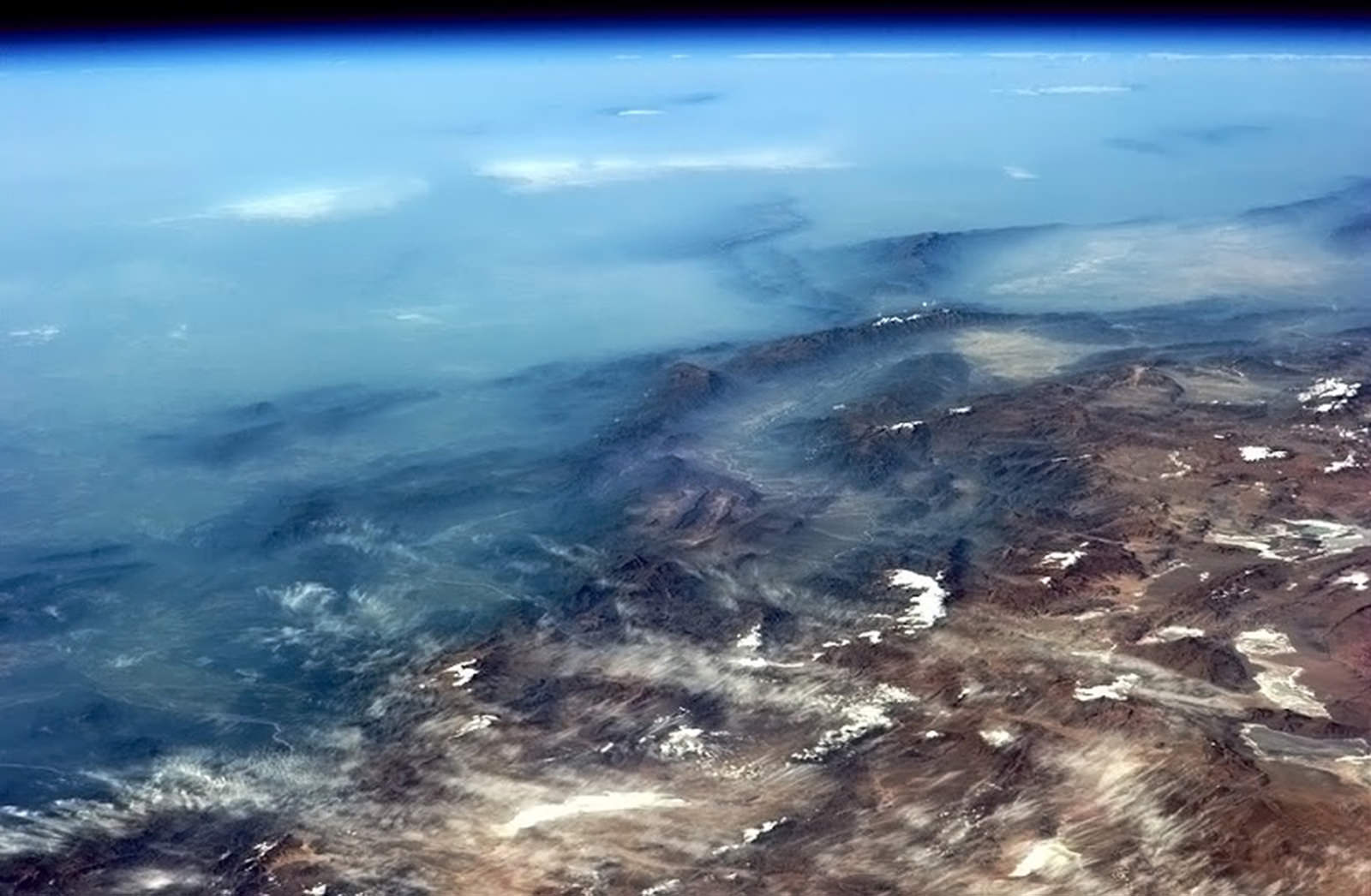Ah, the nerdy joys of living in the 21st century! Chris Hadfield, an astronaut on board the International Space Station and William Shatner, who portrayed someone in space, were able to talk to each other live. After Captain Kirk opened hailing frequencies, Hadfield replied — using some Star Trek sound effects. Needless to say, when science fiction and reality collide like this, it is an epic day in nerdom.
Mercury’s False Moon: The Mercury/Mars Planetary Conjunction this Weekend
[/caption]
The history of astronomy is littered with astronomical objects in the solar system that have fallen to the wayside. These include fleeting sightings of Venusian moons, inter-mercurial planets, and even secondary moons of the Earth.
While none of these observations ever amounted to true discoveries, this weekend gives observers and astrophotographers a unique chance to “mimic” a spurious discovery that has dotted astronomical lore: a visual “pseudo-moon” for the planet Mercury. This “moon illusion” will occur on February 8, 2013 during the closest conjunction of two naked eye planets in 2013. February offers a chance to see the fleeting Mercury in the sky, and this conjunction with Mars will provide the opportunity to see how Mercury would look in the night sky if it had a moon!
Mercury has been suspected of having moons before. On March 29th 1974, the Mariner 10 spacecraft became the first mission to image the innermost world up close. Mariner 10 mapped 40-45% of Mercury on 3 successive passes, revealing a pock-marked world not that different than our own Moon. But Mariner 10 also detected something more: brief anomalies in the ultra-violet spectrum suggestive of a moon with a 3 day period. For a very brief time, Mercury was thought to have a moon of its own, and NASA nearly made a press release to this effect. The spectroscopic binary 31 Crateris is now suspect in the anomalous readings. Still, the Mariner 10 observation made researchers realize the observations in the extreme UV were possible over interstellar distances.

Today, NASA has a permanent emissary orbiting Mercury with its MESSENGER spacecraft. MESSENGER first entered orbit around Mercury on March 18th, 2011 after a series of trajectory changing flybys. MESSENGER has filled in the map of the remainder of Mercury’s surface, with no signs of the anomalous “moon.” Interestingly, MESSENGER was also on the lookout for “Vulcanoids” (tiny asteroids interior to Mercury’s orbit; sorry, Mr. Spock) while enroute to its final orbital insertion. NASA even released an April Fool’s Day prank of a fake “discovery” of a Mercurial moon dubbed Caduceus in 2012.
But MESSENGER has made some fascinating true to life discoveries, such as sampling Mercury’s tenuous exosphere & the possibility of ice at its permanently shadowed poles. Lots of new features have been mapped and named on Mercury, following the convention of naming features after famous deceased artists, musicians and authors set forth by the International Astronomical Union. It’s amazing to think that we had no detailed views at the entire surface of Mercury until the 1970’s, although some ground-based professional observatories and even skilled amateurs are now doing just that.
Fast forward to this weekend. Mercury is just beginning its first apparition of six in 2013 this week and is currently visible low in the dusk sky after sunset to the west. Mercury reaches greatest eastern elongation on February 16th at 18.1° from the Sun. Interestingly, that’s very close to the shortest elongation that can occur. Mercury’s orbit is eccentric enough that greatest elongation as seen from the Earth can vary from 17.9° to 27.8°. This month’s elongation happens within only 5 hours of Mercury reaching perihelion at 46 million kilometers from the Sun. This means that Mercury won’t peak above the dusk horizon for mid-northern latitude observers quite as high as it will during the next evening apparition of the planet in June.
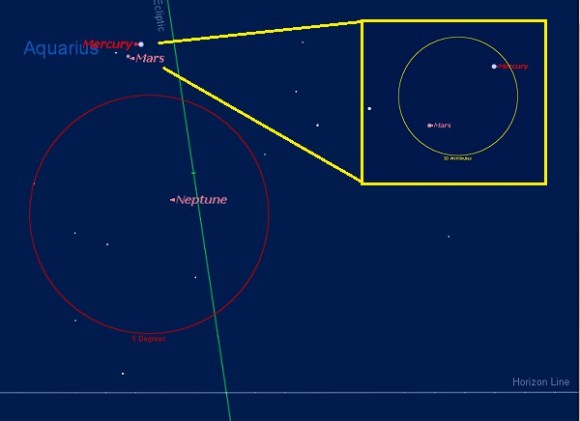
This appearance of Mercury does, however, have some things going for it. First off, the ecliptic sits at a favorable viewing angle, roughly perpendicular to the western horizon at dusk for mid- to high northern latitude observers. This gives Mercury a bit of a “boost” out of the weeds. Secondly, Mercury is a full magnitude (2.512 times) brighter when it reaches maximum elongation near perihelion than aphelion, such as its next appearance in the dawn sky on March 31st of this year. Mercury will reach magnitude -0.5, versus +0.5 in late March.
To see Mercury, find a site with a western horizon free of ground clutter and start sweeping the horizon with binoculars about 15 minutes after local sunset. See a reddish dot just above Mercury? That’s the planet Mars, shining about 7 times fainter than -1.0 magnitude Mercury at magnitude +1.2. Mercury is fast approaching a conjunction with Mars; the two will be only 15’ apart (half the average width of a Full Moon) on the evening of February 8th at 17:00 Universal Time!
If you ever wondered how Mercury would appear with a moon, now is a good time to take a look! Again, binoculars are the best optical tool for the job. Can you see both with the naked eye? Can you place both in the same low power field of view with a telescope? You’ll only have a 15-30 minute window (depending on latitude) to snare the pairing before they follow the setting Sun below the horizon. Photographing the pair will be tricky, though not impossible, as they present a very low contrast against the bright background twilight sky.

Don’t expect to see detail on Mercury or Mars telescopically; Mercury only appears 5.8” across on the 8th, while Mars is 4” in apparent size. Mars disappears from view later this month to reach solar conjunction on April 18th 2013. The waxing crescent Moon just 1 day after New joins the pair on the evenings of February 10th and 11th.
Now for the “Wow” factor of what you’re seeing. The conjunction of Mars and Mercury only appears close; in reality, they are over 180 million kilometers apart. Mercury is 1.15 Astronomical Units (A.U.s)/178 million kilometers from us on February 8th, while Mars is nearly at its farthest from us at 2.31 A.U.s/358 million kilometers distant. It’s splendid to think that with Curiosity and friends operating on Mars and Messenger orbiting Mercury, we now have permanent robotic “eyes” on and around both!
Credits: Simulation created by the author using Starry Night.
Mercury & Mars courtesy of Mike Weasner and the Cassiopeia Observatory. Used with permission.
Deep Impact Images Spectacular incoming Comet ISON – Curiosity & NASA Armada Will Try
Image Caption: This image of comet ISON (C/2012 S1) ) from NASA’s Deep Impact spacecraft clearly shows the coma and nucleus on Jan. 17/18, 2013 beyond the orbit of Jupiter. See the dramatic new movie sequence below. It combines all 146 80-second clear filter exposures for a total integration time of 11680 seconds (about 3.25 hours). Individual frames were shifted to align the comet at the center before coadding. By keeping the comet centered and adding all of the images together, the stars effectively get smeared so the long streaks are the trails of background stars. Some have called it the “Comet of the Century.” Credit: NASA
NASA’s legendary Deep Impact comet smashing spacecraft has just scored another major coup – Imaging the newly discovered Comet ISON. The comet could possibly become one of the brightest comets ever late this year as it passes through the inner Solar System and swings around the Sun for the very first time in history – loaded with pristine, volatile material just raring to burst violently forth from the eerie surface, and is therefore extremely interesting to scientists. See the Movie below
“Comet ISON was just imaged by Deep Impact out by Jupiter on Jan. 17 and 18,” said Dr. Jim Green, Director of NASA Planetary Sciences at NASA HQ, in an exclusive interview with Universe Today on the campus of Princeton University. “We will try to look at ISON with the Curiosity rover as it flies past Mars, and with other NASA assets in space [along the way]. It should be spectacular!”
“We are all, ops team and science team, thrilled that we were able to make these observations when the comet was still more than 5 AU from the sun,” said Deep Impact Principal Investigator Prof. Michael A’Hearn of the University of Maryland, in an exclusive interview with Universe Today.
ISON could potentially become the next “Great Comet”, according to NASA. Deep Impact is the first spacecraft to observe ISON.
“We are continuing to observe ISON – it is observable from Deep Impact into mid-March 2013,” A’Hearn told me.
ISON will be the 4th comet observed by Deep Impact. On July 4, 2005 the spacecraft conducted a close flyby of Comet Tempel 1 and delivered a comet smashing impactor that made headlines worldwide. Next, it flew near Hartley 2 in Nov. 2010. In January 2012, the spacecraft performed a long distance imaging campaign on comet C/2009 P1 (Garradd). And it has enough fuel remaining for an Asteroid encounter slated for 2020 !
“NASA’s assets at Mars should be able to observe ISON because it will fly really, really close to Mars!” Green said with a big smile – and me too, as he showed me a sneak preview of the brand new Deep Impact movie.
“ISON observations are in the cue for Curiosity from Mars surface and from orbit with NASA’s Mars Reconnaissance Orbiter (MRO) – and we’ll see how it works out. It should be pretty spectacular. We will absolutely try with Curiosity’s high resolution Mastcam 100 camera.”
“LRO (NASA’s Lunar Reconnaissance Orbiter) also has a good shot at ISON.”
“Because of the possibility of observations of for example ISON, with probes like Deep Impact is why we want to keep NASA’s [older] assets viable.”
146 visible light images snapped by Deep Impact just days ago on Jan. 17 and 18, have been compiled into a dramatic video showing ISON speeding through interplanetary space back dropped by distant star fields – see above and below. The new images were taken by the probes Medium-Resolution Imager (MRI) over a 36-hour period from a distance of 493 million miles (793 million kilometers).
“A composite image, combining all of the Jan 17/18 data – after cleaning up the cosmic rays and improving the S/N (signal to noise ratio) clearly shows the comet has a coma and tail,” said Tony Farnham, a Deep Impact research scientist at the University of Maryland, to Universe Today.
Video Caption: This series of images of comet C/2012 S1 (ISON) was taken by the Medium-Resolution Imager (MRI) of NASA’s Deep Impact spacecraft over a 36-hour period on Jan. 17 and 18, 2013. At the time, the spacecraft was 493 million miles (793 million kilometers) from the comet. Credit: NASA/JPL-Caltech/UMD
ISON is a conglomeration of ice and dust and a long period, sun-grazing comet.
“It is coming in from the Solar System’s Oort cloud at the edge of the Solar System”, said Green, and was likely disturbed out of its established orbit by a passing star or other gravitational effects stemming from the Milky Way galaxy. “It will pass within 2.2 solar radii during perihelion and the Sun will either blast it apart or it will survive.”
Despite still being in the outer Solar System and a long distance from the Sun, ISON is already quite “variable” said A’Hearn, and it’s actively spewing material and ‘outgassing”.
The tail extending from the nucleus was already more than 40,000 miles (64,400 kilometers) long on Jan. 18. It’s a science mystery as to why and the Deep Impact team aims to try and determine why.
In addition to imaging, Deep Impact will also begin collecting long range spectral observations in the next week or so to help answer key questions.
“In mid-February, the solar elongation will allow IR (infrared) spectra for a few weeks,” A’Hearn elaborated.
“The 6-7% variability that we observed in the first day of observing shows that there is variable ‘outgassing’, presumably modulated by rotation of the nucleus. We hope to pin down the rotational period with the continuing images.”
“The interesting question is what drives the outgassing!”
Since ISON is still a very great distance away at more than 5 AU, data collection will not be an easy task. The comet is 5.1 AU from the Sun and 5.3 AU from Deep Impact. And the mission could also be imperiled by looming slashes to NASA’s budget if the Federal sequester actually happens in March.
“Getting spectra will be a real challenge because, at these large heliocentric and geocentric distances, the comet is really faint. However, maybe we can test whether CO2 is driving the outgassing,” Ahearn explained.
“Since we have the only facility capable of measuring CO2, it will be important to observe again in our second window in July-August, but that depends on NASA finding a little more money for us.”
“We, both the ops team and the science team, are funded only for the observations through March,” A’Hearn stated.
Although observing predictions for the brightness of comets are sometimes notoriously wrong and they can fade away precipitously, there is some well founded hope that ISON could put on a spectacular sky show for observers in both the northern and southern hemispheres.
The comet will continue to expand in size and grow in brightness as it journeys inward.
“ISON might be pretty spectacular,” said Green. “If things work out it might become bright enough to see during the day and be brighter than the Moon. The tail might be 90 degrees.”
Image caption: This is the orbital trajectory of comet C/2012 S1 (ISON). The comet is currently located just inside the orbit of Jupiter. In November 2013, ISON will pass less than 1.1 million miles (1.8 million kilometers) from the sun’s surface. The fierce heating it experiences during this close approach to the sun could turn the comet into a bright naked-eye object. Credit: NASA/JPL-Caltech
The best times to observe the comets head and growing tail will be from Nov. 2013 to Jan. 2014, if it survives its closest approach to the Sun, known as perihelion, on Nov. 28, 2013 and doesn’t break apart.
There’s no need to worry about doomsday predictions from conspiracy theorists. At its closest approach next Christmas season on Dec. 26, 2013, ISON will pass by Earth at a safe distance of some 40 million miles.
A pair of Russian astronomers only recently discovered the comet on Sept. 21, 2012, using the International Scientific Optical Network’s 16-inch (40-centimeter) telescope near Kislovodsk.
The study of comets has very important implications for understanding the evolution of not just the Solar System but also the origin of life on Earth. Comets delivered a significant portion of the early Earth’s water as well as a range of both simple and complex organic molecules – the building blocks of life.
Image caption. Deep Impact images Comet Tempel 1 alive with light after colliding with the impactor spacecraft on July 4, 2005. CREDIT: NASA/JPL-Caltech/UMD
Earthlike Exoplanets Are All Around Us
Artist’s impression of a rocky planet orbiting a red dwarf. Credit: David A. Aguilar (CfA)
We may literally be surrounded by potentially habitable exoplanets, according to new research by a team from the Harvard-Smithsonian Center for Astrophysics.
Using data gathered by NASA’s exoplanet-hunting Kepler spacecraft, the CfA researchers discovered that many red dwarf stars harbor planets, and some of those planets are rocky, Earth-sized worlds. Considering that red dwarfs, albeit optically dim, are the most abundant type of stars in our galaxy, this means that even a small percentage of them being host to Earthlike exoplanets puts the total number of potentially habitable worlds very high — and some of them could be right next door.
“We thought we would have to search vast distances to find an Earth-like planet,” said CfA astronomer and the paper’s lead author Courtney Dressing. “Now we realize another Earth is probably in our own backyard, waiting to be spotted.”
And our own backyard, in cosmic terms, could mean a mere 13 light-years away.
Our solar system is surrounded by red dwarfs. You can’t see them in the night sky because they are much too dim — less than a thousandth the brightness of the Sun. But they make up 75% of the stars in the local neighborhood, and based on the Kepler data the CfA team estimates that 6% of those red dwarfs likely have an Earth-sized planet in orbit around them.
And with at least 75 billion red dwarfs scattered across the galaxy… well, you do the math.*
“We now know the rate of occurrence of habitable planets around the most common stars in our galaxy,” said co-author David Charbonneau (CfA). “That rate implies that it will be significantly easier to search for life beyond the solar system than we previously thought.”
A visualization of the “unseen” red dwarfs in the night sky. Credit: D. Aguilar & C. Pulliam (CfA) See original here.
The conditions on a planet orbiting a red dwarf wouldn’t be exactly like Earth, of course. The planet would have to orbit rather closely to its star to be within its habitable zone, and would have to have a reasonably thick atmosphere to regulate heat and protect it from stellar outbursts. But one benefit to orbiting a red dwarf is that they have very long life spans — potentially longer than the current age of the Universe! So a habitable world around a red dwarf would literally have billions of years for life to evolve, thrive and develop on it.
“We might find an Earth that’s 10 billion years old,” Charbonneau said.
The team’s findings were presented today, Feb. 6, by Dressing during a press conference at the Harvard-Smithsonian Center for Astrophysics in Cambridge, MA. The results will be published in The Astrophysical Journal. (Added 2/7/13: here’s the video of the press conference.)
CfA astronomers identified 95 planetary candidates circling red dwarf stars. Of those, three orbit within the habitable zone (marked in green) – the distance at which they should be warm enough to host liquid water on the surface. Those three planetary candidates (marked with blue dots) are 0.9, 1.4, and 1.7 times the size of Earth. Credit: C. Dressing (CfA)
Read more on the CfA news release here.
*Ok, I did the math. That’s 4,500,000,000 Earth-like exoplanets around red dwarfs alone!
Fly Over a Pristine Lunar Crater

Linné crater on the Moon is one of the youngest, most well-preserved lunar impact craters. This cone-shaped crater thought to be less than 10 million years old – a mere whippersnapper when it comes to impact craters. Scientists have been studying this crater for years, using it to investigate how cratering occurs in mare basalt. This “barnstorming” flyover video was created with data from the Lunar Reconnaissance Orbiter.
LRO helped discern the actual shape of this crater, and other craters too. It was once thought that the circular Linné crater was bowl-shaped, and that set a precedent for understanding the morphology of craters on the Moon, and also on Earth. But laser-mapping observations by NASA’s Lunar Reconnaissance Orbiter determined Linné is actually more of a truncated inverted cone, with a flattened interior floor surrounded by sloping walls that rise up over half a kilometer to its rim.
It’s a magnificent crater, and enjoy this unique chance to see it up close.
Super Good at Collecting Data, Massive Science Balloon Breaks Records
Super-TIGER prepares for launch from Antarctica.
NASA’s Super-TIGER science balloon landed Friday at a frigid and remote base in Antarctica after setting two duration records while gathering data about cosmic rays. There’s so much data that it will take scientists about two years to analyze, according to NASA.
Launched December 8, 2012 from the Long Duration Balloon site near McMurdo Station in Antarctica, the Super Trans-Iron Galactic Element Recorder balloon spent 55 days, 1 hour and 34 minutes aloft, shattering records previously set in 2009 by another NASA balloon for longest flight by a balloon of its size. The 39-million cubic foot balloon, spent most of its time cruising four times higher than commercial airlines at about 127,000 feet (almost 39 kilometers). The instrument is managed by Washington University in St. Louis, Missouri.
“Scientific balloons give scientists the ability to gather critical science data for a long duration at a very low relative cost,” said Vernon Jones, NASA’s Balloon Program scientist, in the press release. “Super-TIGER is scientific ballooning at its best.”
Super-TIGER measured rare heavy elements, such as iron, as they bombarded Earth from the Milky Way. The instrument detected about 50 million of these high-energy cosmic rays. Scientists hope the data from the mission will help understand where the energetic nuclei are produced and how they achieve such high energies.
NASA had three long-duration balloon missions in the summer skies of Antarctica. SuperTIGER was joined by BLAST and EBEX. All three balloons launched from the site near McMurdo Station in December. BLAST, or Balloon Borne Large Aperture Submillimeter Telescope launched Christmas Day and measured the polarized dust in star-forming regions helping astronomers determine if magnetic fields are a dominant force over turbulence in star-forming regions of the galaxy. BLAST’s mission lasted just over 16 days.
EBEX, the heaviest scientific payload borne aloft by a NASA balloon, measures cosmic microwave background radiation. The mission lasted 25 days and reached altitudes of 118,000 feet (or 36 kilometers).
Antarctica, it turns out, is ideal for these types of long-duration balloon missions with sparse populations and anticyclonic (east to west, counter-clockwise in the southern hemisphere) wind patterns in the stratosphere.
Source: NASA
Space Generations: Gene Cernan Talks with ISS Crew
It was a feel-good moment in NASA’s Mission Control in Houston: Apollo astronaut Gene Cernan dialed up the International Space Station crew to chat. There was banter back and forth about how Cernan was part of the generation that inspired the current ISS crew, and how the ISS crews are inspiring the next generation.
“You are now the shoulders for the kids to stand upon,” Cernan told ISS commander Kevin Ford. Cernan, who has expressed dismay at NASA’s current path, said he was mightily impressed with what the ISS crews are doing. “I’m envious,” he said. “I wish I could be up there with you. You guys are doing one heckuva great job. You have a big legacy to build upon and from where you leave off we’re gonna get these kids down here excited about pressing on and going even further… I’m personally proud.”
Incredible Space Shuttle Picture: Is it Real?
This fantastic — or perhaps fantastical — image of a space shuttle launching through the clouds has been getting a lot of comments on the social media circuits. But is it real?
No, it is a composite of two different images put together by photographer Richard Silvera.
“The picture of the sky and clouds was taken by me from an airplane,” Silvera wrote on his website, “and the shuttle is a picture from NASA. Then the assembly was done in Photoshop & Lightroom.”
While this is a beautiful image, as some have commented on the G+ Space Community, there are several tell-tail signatures that this image could never have been taken. The shuttle did not launch perfectly vertical (roll program starts shortly after launch, about 10 seconds after main engine ignition), and with the restrictions on aircraft being in the area during a launch, no one could have had this perspective and been so close as to take a picture like this.
However, here is a “real” image to compare, of Atlantis launching through the clouds, during the STS-129 mission in 2009:
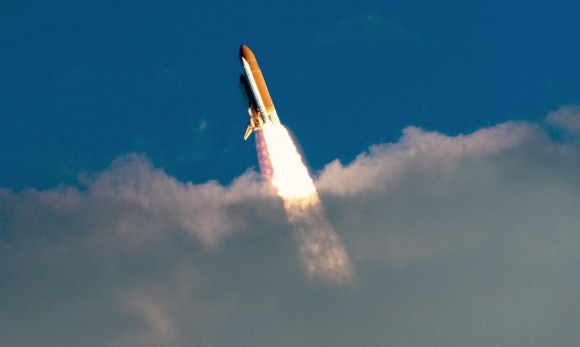
Thanks to Richard Silvera for allowing UT to post his composite image. You can see more of his work on his website.
Another Weird Shiny Thing on Mars

The Curiosity Mars rover has found some strange-looking little things on Mars – you’ve likely heard of the Mars ‘flower,’ the piece of benign plastic from the rover itself, and other bright flecks of granules in the Martian soil. Now the rover has imaged a small metallic-looking protuberance on a rock. Visible in the image above (the green lines point to it), the protuberance appears to have a high albedo and even projects a shadow on the rock below. The image was taken with the right Mastcam on Curiosity on Sol 173 — January 30, 2013 here on Earth — (see the original raw image here), and was pointed out to us by Elisabetta Bonora, an image editing enthusiast from Italy.
“The corresponding image from the left Mastcam is not there,” said Bonora via email, “which is a real shame because this would allow us to make an anaglyph.”
UPDATE: Since yesterday when we posted this, the left Mastcam image is now available, and so Bonora has put a 3-D view of this little metal-looking thingy. After seeing this anaglyph, it is even more perplexing! Make sure you view it with the red/green 3-D glasses:
See below:
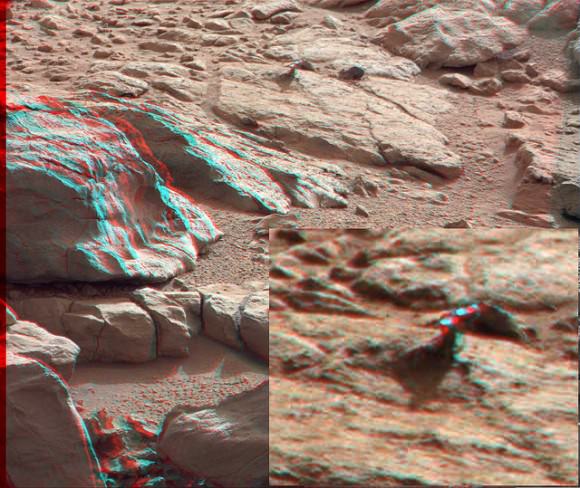
As Bonora pointed out, the protuberance seems different than the rock on which it sits – it could be composed of material more resistant to erosion than the rest and similar material could be within the rock, or it could be something that is “grown” on the rock.
However, it looks fairly smooth, and in fact it is not covered by dust as is the case for metal surfaces that tend to clean easily.
But “small” is the operative word here, as the little protuberance is probably about 0.5 cm tall, or even smaller 3 centimeters tall, according to the image editing specialists at UnmannedSpaceflight.com.
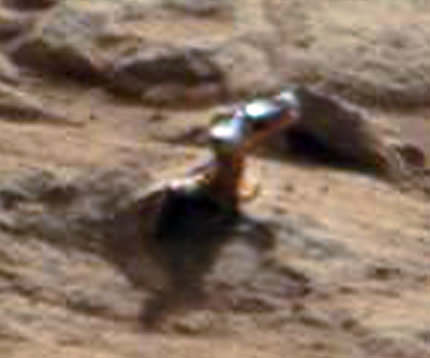

Here’s a full panorama of the area:

Whatever it is, the weird little shiny thing is interesting, and we hope to have more details about it soon from one of the rover scientists.
See all the raw rover images on the MSL website, and more images on Bonora’s Flickr page.
Another Amazing Earth View: The Andes Under a Blue Pacific Fog
View of the Andes from the ISS on Feb. 4, 2013 (NASA)
Even though he’s a busy guy, Expedition 34 astronaut Chris Hadfield still takes the time to share some of his amazing views from orbit aboard the ISS. One of his most recent photos is this stunning view of Andean ridges rising up from a blue haze of Pacific fog, the arc of Earth’s horizon in the distance. Gorgeous! (Edit: according to a labeled image by Peter Caltner, this is looking southeast into northern Argentina – no Pacific in view. So the haze is coming from the valley, not the ocean.)
Shared on Twitter at 6:25 p.m. EST, this has quickly become one of Hadfield’s more popular images — and for good reason. In fact sometimes it’s hard to keep up with this high-flying Canadian, who easily posts half a dozen or more photos from all across the world every day on Twitter, Facebook, and his Google+ profile (which is managed by his son Evan.) But since the ISS goes around the globe 16 times a day, there’s certainly no shortage of sights for Chris and the Exp. 34 crew!
Check out a few more of Chris Hadfield’s recent photos below:
The Mississippi delta deposits “the soil of America’s heartland” into the Gulf of Mexico (NASA)
“It’s a bird, it’s a plane… it’s a river in South America!” tweeted Hadfield. (Actually it’s looking west along the Rio São Francisco river in Brazil.) NASA
Chesapeake Bay from orbit. “You can even see the causeway,” Hadfield noted. (NASA)
On Feb. 2, Hadfield took this photo of storm clouds over Africa. “My breath was taken away,” he wrote. (NASA)
Toronto on the shore of Lake Ontario, “Canada’s most populous city” (NASA)
Want to see more of Chris Hadfield’s images from orbit? Follow him on Twitter and Facebook and over on Google+. (Just don’t be surprised if you find yourself changing your desktop background a lot more often!)
And for even more space adventures, tune in to the CSA website on February 7 at 10:30 a.m. EST when Col. Hadfield will have a live chat with William Shatner, building upon their brief (but immensely popular) impromptu web conversation from last month. He’ll also be taking questions from “space tweeps” on-site at CSA.


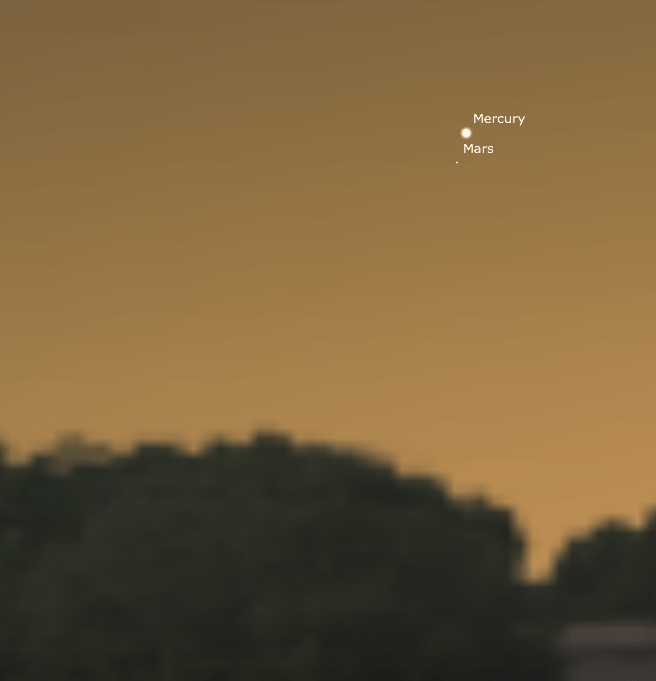
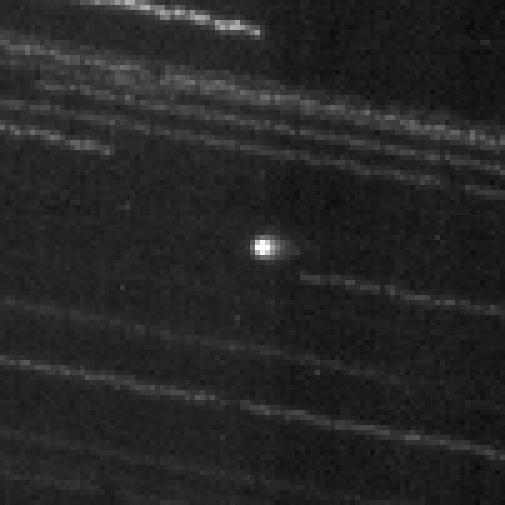

![HRI_937_1[1]](https://www.universetoday.com/wp-content/uploads/2013/02/HRI_937_11-580x580.jpg)
